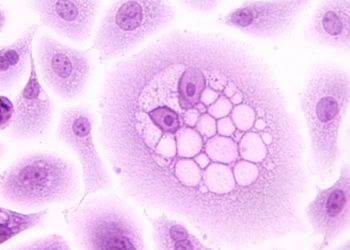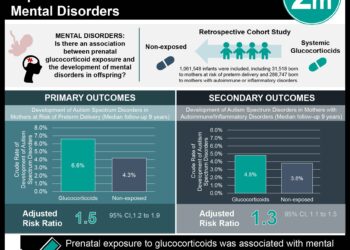2 Minute Medicine Rewind October 30, 2017
Surgery for Drug-Resistant Epilepsy in Children
The role of surgery in cases of drug-resistant recalcitrant epilepsy in children and adolescents is currently unclear. In this randomized control trial, 116 patients age 18 years or younger were randomized to receive neurosurgery and medical therapy or medical therapy alone to determine whether surgery improves freedom from seizures after 12 months. Researchers found that at 12 months of follow-up, 77% of patients in the surgery group and 7% of patients in the medical therapy group had complete freedom from seizures (absolute difference 70.4%, 95% CI 57.8 to 83.1, p<0.001). Patients in the control group were significantly more likely to experience seizure recurrence (RR 4.09, 95% CI 2.52 to 6.62) in comparison to the surgery group. Researchers also found that the type of surgery performed was associated with the likelihood of seizure freedom, where all patients who received temporal lobectomy or hypothalamic hamartoma surgeries had complete freedom from seizures, while 92% of patients who underwent extratemporal resection and 87% of patients who underwent a hemispherotomy had complete freedom from seizures. In terms of secondary outcomes, there were statistically significant differences between the groups in terms of changes in seizure severity as per the Hague Seizure Severity scale (difference 19.4, 95% CI 15.8 to 23.1, p<0.001), as well as pediatric quality of life (p<0.001). Taken together, the results of this study suggest that brain surgery for children and adolescents with drug-resistant recalcitrant epilepsy improves the rate of complete freedom from seizures compared to medical therapy alone, and results in an overall improvement in quality of life. It is important to note that this study was conducted in a single center, patients underwent many different types of surgeries for different types of pathological causes of seizures, and hypothalamic hamartomas were over-represented in the trial. As such, larger sample size studies would are needed in producing further data on specific approaches to surgery.
Few studies have characterized and quantified the burden of cancer among young adults. In this population-based study, investigators disease burden in young adults age 20 to 39 years of age, and compared the degree of burden across age groups. The data source used for this study was the International Agency for Research on Cancer’s GLOBOCAN 2012, which provides estimates of incidence, prevalence, and mortality for all cancers combined and for 27 major types as defined by the International Classification of Disease (tenth revision) in 184 countries. Researchers found that an estimated 975,396 new cancer cases and 358,392 cancer-associated deaths occurred in young adults worldwide in 2012. The age-standardized rate (ASR) of cancer was 43.3 new cancer cases per 100,000 people per year, and the mortality ASR was 15.9 cancer-associated deaths per 100,000 people per year. Compared to children aged 0-19 years old, the burden of cancer in young adults was higher with approximately four times the number of new cases, with approximately three times the number of cancer-associated deaths. The burden was disproportionately greater among women. The number of new cases and deaths was lower in young adults in comparison to older individuals. There was a spectrum of cancers observed in young adults including leukemia, cancers of the brain, and common epithelial tumors such as breast cancer. In terms of the effect of socioeconomic factors, the incidence of cancers increased for countries with higher scores on the Human Development Index (HDI), however cancer-related mortality decreased with higher HDI scores. The types of common cancers and types of fatal cancers also differed depending on HDI stratification. Overall, the findings from this study indicate that there is an important cancer burden in adults from age 20 to 39 years old, with variation across age groups, development level and geographical regions.
Patients with human papillomavirus (HPV) positive oropharyngeal squamous cell carcinoma (OPSCC) are more likely to be younger, often lacking traditional risk factors. These patients also have a better prognosis compared to patients with HPV-negative OPSCC. As such, the pathologic staging system implemented by the American Joint Committee on Cancer (AJCC) has recently been updated to feature separate staging criteria for HPV-positive patients. Whether this new staging system (AJCC-8) is clinically efficacious as a prognostic tool and whether other pathologic variables, such as perineural invasion (PNI) and angiolymphatic invasion, have any prognostic significance, however, is unclear. In this retrospective cohort study, investigators analyzed data on 201 surgically treated patients with HPV-positive OPSCC in order to examine the prognostic value of PNI and ALI in terms of overall survival. Researchers found that the presence of either ALI or PNI was associated with poorer overall survival after adjusting for other factors such as age, smoking, AJCC-8 stage and radiation dose (HR 2.78, 95% CI 1.15 to 6.76). Out of the AJCC-8 stages, patients with stage II OPSCC who had ALI and/or PNI had a worse overall survival (HR 11.7, 95% CI 1.2 to 111.7). Overall, the results suggest that the presence of ALI and PNI could provide additional, clinically useful information in prognosticating patients with AJCC-8 stage II OPSCC.
Von Hippel-Lindau (VHL) disease is caused by a germline mutation in the VHL tumour suppressor gene. Compared to sporadic pancreatic neuroendocrine tumours (PNETs), patients with PNETs in the context of VHL have a better prognosis. In this prospective cohort study, 229 patients age 12 years or older with VHL disease and a pancreatic manifestation of VHL were followed up to evaluate the natural history of VHL disease-associated pancreatic lesions and to determine what factors are associated with PNET phenotype and prognosis. Researchers found that patients with VHL mutations in exon 3 had a higher rate of PNETs (OR 2.8, 95% CI 1.3 to 6.1, p=0.01) compared to patients with mutations in exons 1 or 2. Among patients with PNETs, 16.6% required surgical intervention. Researchers also found that patients with a tumour diameter greater than 3.0 cm were at an increased risk of developing metastatic disease (HR 8.6, 95% CI 1.7 to 43.2, p=0.009) when compared to patients with a greatest tumour diameter less than 1.2 cm. Among patients with a PNET diameter of 1.2 cm or greater and 3 cm or less, only those with a VHL missense mutation developed metastatic disease during follow-up (p=0.04). These patients also had a higher rate of requiring a surgical intervention compared to other mutation types (p=0.04), as did patients with a mutation in exon 3 versus other VHL genotypes (HR 8.8, 95% CI 1.2 to 66.vhl3, p=0.04). This study therefore provides evidence for risk stratification in patients with VHL-associated pancreatic lesions, using factors such as tumour size and mutation type.
Delayed versus immediate cord clamping in preterm infants
Delayed umbilical cord clamping may be beneficial in preterm infants, increasing the amount of placental blood received and easing the physiological transition from fetal to newborn life. While this had been routine in the delivery of preterm infants, concerns surrounding delayed resuscitation, hypothermia, hyperbilirubinemia and polycythemia have brought this practice into question. In this randomized controlled trial, 1566 fetuses were randomized to immediate cord clamping or delayed cord clamping to compare morbidity and mortality in preterm infants. The median time between delivery and clamping was 5 seconds in the immediate clamping group, versus 60 seconds in the delayed clamping group. Researchers found that there was no significant difference in the incidence of death or major morbidity by 36 weeks of postmenstrual age (RR 1.0, 95% CI 0.88 to 1.13, p=0.96). There were also no significant differences between the groups in terms of incidences of chronic lung disease or other major morbidities. This study therefore shows that among preterm infants, delayed cord clamping does not result in a reduction in mortality or major morbidity at 36 weeks of age, when compared to immediate clamping.
Image: PD
©2017 2 Minute Medicine, Inc. All rights reserved. No works may be reproduced without expressed written consent from 2 Minute Medicine, Inc. Inquire about licensing here. No article should be construed as medical advice and is not intended as such by the authors or by 2 Minute Medicine, Inc.







